There’s little doubt that we live today in interesting times. In recent months, Americans have been confronted with deep, seemingly insurmountable problems. Divisions among neighbors and families. The pain of economic loss and the specter of illness and death. We’ve sacrificed lives. We’ve sacrificed livelihoods. And now we are in the middle of a national conversation that calls into question even the most fundamental tenets of our civic faith. The bonds between fellow citizens are more tentative and strained than we can recall.
It would be easy to believe that these pains, and these sacrifices, are unique to history. That no other generation could comprehend such a beleaguered condition. Of course, even a cursory glance back through the trials of our parents and grandparents proves us wrong.
But, among all our current crises, maybe the crisis of our common history is the most painful. After all, the stories we tell about our mothers and fathers, our leaders and our communities, are what have given us grounding. They’ve provided the context, and the language, we use to explain ourselves. If our history weren’t so desperately important to us, we wouldn’t be fighting each other so viciously over it. Each remembered character, and each remembered place, is precious to the one who remembers.
Here in the pages of the Zephyr, we dedicate a lot of our memory to the National Parks. Mostly because they’ve changed so much over the years. Overcrowding and over-exploitation can degrade even the most spectacular landscapes. Before the recent Pandemic, the ceaseless torrent of visitors to places like Zion National Park, Arches National Park, and Yosemite National Park had rendered the spots unrecognizable. Packed into shuttle buses and jostling against each other at each view point, the tourists weren’t enjoying a retreat from the city streets. They had only brought the city streets with them.
To find a retreat in the Parks in the 21st century can be less a matter of location than of memory. To find real solace and recuperation, we can travel back into the decades, to a time when the National Parks could really heal men’s souls.
THE PARKS IN WARTIME
When the photographer Ansel Adams arrived home for Christmas of 1943, it was to a wartime Yosemite Valley. He and his wife Virginia had been living and working out of her father’s photographic studio since the mid-20s, and they had seen the Park through every phase of the ensuing decades. In the boom years of the latter-20s, he befriended his fellow concessionaires—the Yosemite Park and Curry company, who had thrown themselves into the construction of new hotels like the grand Ahwahnee. When hopes for a steady stream of wealthy tourists to the park were crushed by the stock market crash and ensuing Depression, Adams found work shooting promotional photography for the company, and the National Park itself, through the deathly quiet of the thirties. He and Virginia witnessed the steady stream of CCC boys who were put to work throughout the Valley.
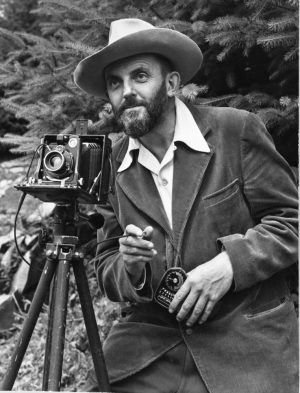
The Adams family had welcomed the small respite as the Depression lifted. Adams took on a new commission—shooting photos of federal lands for the Interior Department—in early 1941. In the fall of that year, he shot one of his most famous photographs—the moonrise over Hernandez, New Mexico. Then, only five weeks later, Pearl Harbor brought everything to a halt. The war arrived everywhere, all at once. Even at Yosemite Valley. The next year passed in a fever, as he sought out some way to contribute to the war effort. And, when Ansel returned home to Best’s studio for Christmas of 1943, he knew it would be unlike any Christmas before.
At the advent of World War II, the National Parks had just begun to recover from the economic pain of the Depression years. Visitation at Yosemite in 1941 reached roughly 500,000, matching pre-Depression numbers for the first time. The recent projects on park infrastructure, built by the Civilian Conservation Corps through the New Deal, were put to use as tourists returned to the parks.
In one day—December 7th, 1941—the focus of the entire nation altered. The deprivations of the Depression had been painful, and the recovery was still on uncertain footing. But, immediately, the national spirit of sacrifice returned. Every company, every organization, every man, woman and child sought to contribute to the national defense.
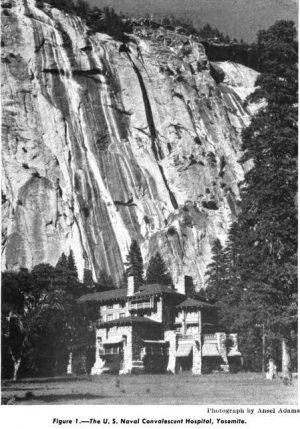
Adams lobbied for military work. As a forty-year-old husband and father, he wasn’t draft material. But he hoped for a commission with a special Navy unit, photographing aircraft with Edward Steichen. When that fell through, in 1942, he took a job at the Art Center School in Los Angeles, thinking that the Signal Corps would send its men there for training. The Signal Corps didn’t appear, and finally he took what odd jobs the military could throw him as a civilian. He made prints of classified negatives, surveillance shots of Japanese forces in the Aleutian Islands. He taught photography to troops at Fort Ord. And he found work close to home, shooting Yosemite Valley and its famed Ahwahnee Hotel in anticipation of its conversion for wartime use.
The changes to the Park Service had been severe. After Pearl Harbor, Park Service director Newton Drury announced that the Park Service would stop advertising to attract visitors. Each park would cut staff and administration to a bare minimum, cease any unnecessary maintenance projects, and eliminate all but the most essential expenses. At the Grand Canyon, the Bright Angel Lodge was closed. Passenger train travel to the Canyon ceased, as did bus tours. The Federal Government shut down the US Travel Bureau, discouraged unnecessary travel for all citizens, and began rationing rubber and gasoline for war use. Tourism, as a national pastime, was put on hold. And, save for the wisdom of Drury, and certain members of the Military, Yosemite and the rest of the National Parks might have waited out the war on indefinite furlough.
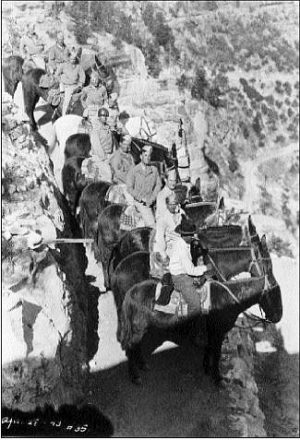
Less than a year after the US entry into the war, the War Department, the Park Service, and several of the largest NPS concessionaires met to discuss how the Parks could serve the war effort. The Park Service leadership was nervous about the military commandeering their parks for training purposes, foreseeing possible damage to the lands they oversaw. The concessionaires were devastated by the loss of tourism dollars, and needed federal help to survive another collapse in income so close on the heels of the Depression. And, lastly, the Military needed facilities—for training purposes, for hospitals, and for the general recreation and morale-boosting of troops stationed at home.
In the end, everyone left the meeting satisfied. The War Department agreed that it would set up recreation camps at a number of parks that were located near military bases, and hospitals at the most suitable locations. They would use park concessions where they could, to help prop up those businesses through the war. And they would train sparingly in the parks, with the help and oversight of Park officials. Director Drury announced that the “best function” of the Parks would be “to prove a place to which members of the armed forces and civilians may retire to restore shattered nerves and to recuperate physically and mentally for the war tasks still ahead of them.”
Thanks to the New Deal years, many of the parks already had CCC barracks and warehouses that were easily converted for the military to use. Recreation Camps were established at Carlsbad Caverns, at Katmai and Denali, and at the Grand Canyon. The NPS printed thousands of brochures for the soldiers, which were distributed at base libraries across the country and at overseas bases.
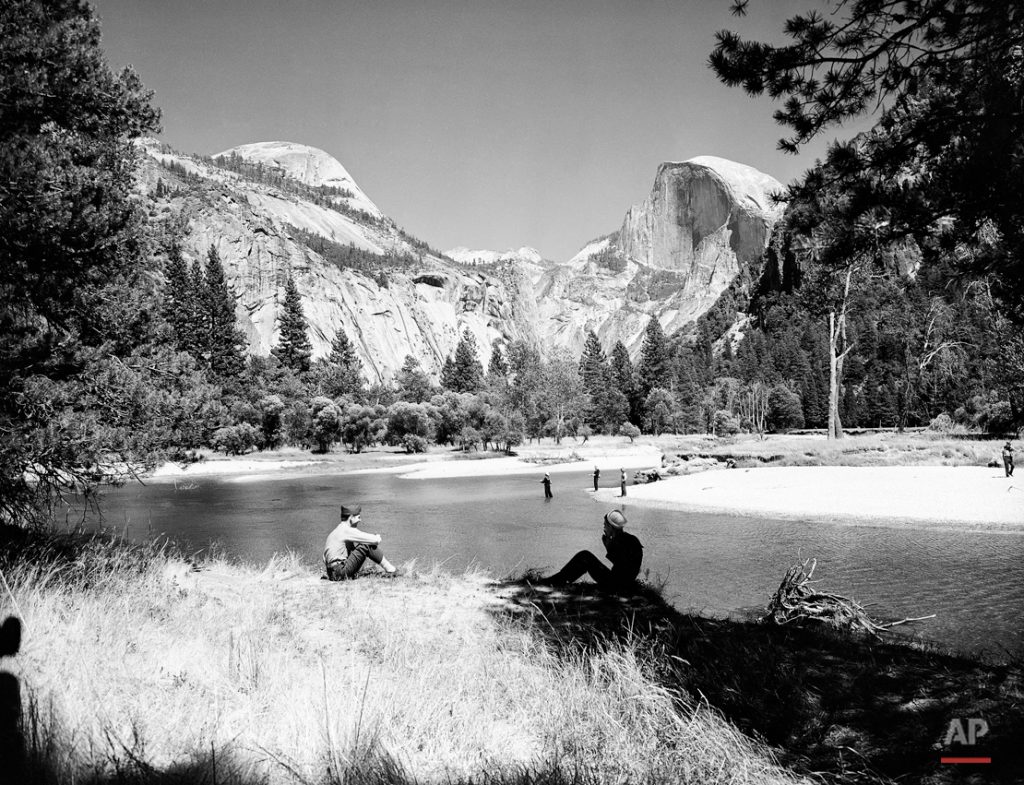
As early as the summer of 1941, anticipating its future needs, the Department of the Navy had surveyed the Parks and other Federal properties, looking for suitable facilities to convert for their use. They discovered a number of prime locations for hospitals, and, by the middle of 1943, they were able to open Naval Hospitals at the Lodge at Sun Valley in Idaho, the Hotel Colorado in Glenwood Springs, Colorado and—perhaps most spectacularly—the luxurious Ahwahnee Hotel in Yosemite National Park.
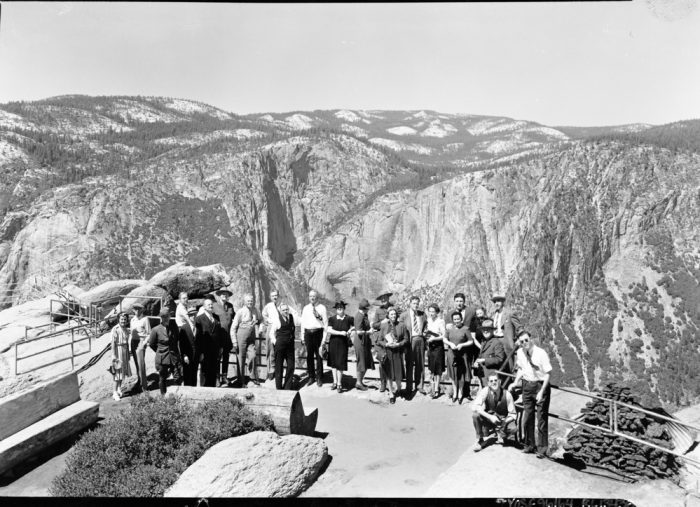
THE AHWAHNEE HOTEL
Brainchild of the Park Service’s first director, Stephen Mather, and the Yosemite Park and Curry Company’s Don Tresidder, the Ahwahnee was built to match the grandeur of its surroundings in Yosemite Valley. The hotel’s large stone hearths and log-beamed ceilings were designed to attract the wealthy and famous to the Park, and attract influential support for the National Parks.
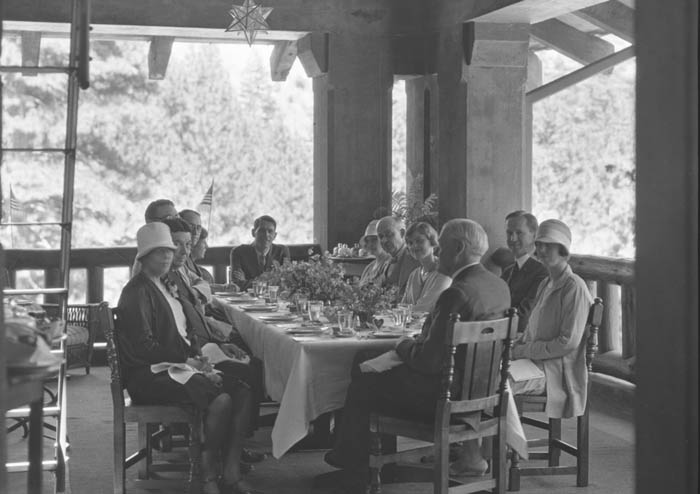
The Hotel opened in 1927, having come in a full 100% over budget, at a hefty million dollars. But the structure was as grand as everyone had dreamed. And thanks to the newly constructed Highway 140 (The “All-Weather Highway”) and the El Portal Road, it was reachable year-round.
Tresidder knew that year-round visitation was key to keeping the luxurious facility afloat, so he pushed for more winter-time activities in the park. Having visited Switzerland in 1928 for the Winter Olympics, he wanted to make Yosemite the “Switzerland of the West.” He formed the Yosemite Winter Club that year, and opened up Toboggan Runs, dog sleds, and sleighing through the park. He flooded the parking lot of Camp Curry for a skating rink and erected ski runs and a chairlift at Badger Pass.
For help attracting visitors to the Ahwahnee itself, he turned to his friend and neighbor in the park, Ansel Adams. Tresidder had an idea for a Christmas Party to outclass all others. A feast, and a Christmas Play, that visitors from San Francisco and Los Angeles would beg to attend.
Adams agreed. He collaborated with Los Angeles-based pageant director Garnet Holme on a script, and composed music—Ansel was also an accomplished concert pianist—for what would be known as the “Bracebridge Dinner.” Based loosely on a Washington Irving story, the play centered on the holidays of an English squire. Tresidder played the role of the Squire, and his wife the role of Lady Bracebridge. Adams himself played the Jester.
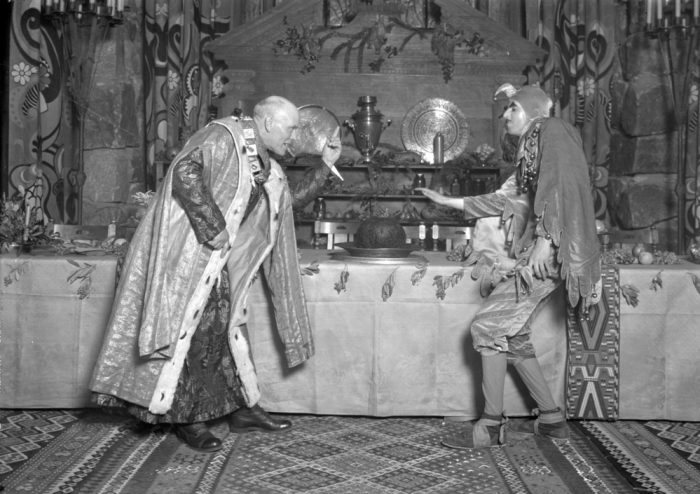
And while he’d written the play as a favor, Bracebridge quickly became a kind of touchstone for Adams. No matter what else was happening, he always returned to Yosemite, and to the Ahwahnee, for Christmas. In 1940, he skipped out on the opening of his very first major exhibition at New York’s Museum of Modern Art in order to be home for Bracebridge. He didn’t miss a year.
But the war left nothing untouched. In 1942, a subdued party had replaced the normal affair at Ahwahnee. Don Tresidder wrote for the local Yosemite Sentinel:
“Dear Reader:
A popular song keeps running through my mind as I ponder over these words of Christmas Greeting. You know the song–“I’m Dreaming of a White Christmas.” Certainly I can’t help but dream a little about other Christmas Seasons—we are going to miss the Yule Log Ceremony and the Bracebridge dinner. But most of all we will miss our friends and associates now with the armed forces or in defense work.
Yes, the Christmas festivities will be more simple this year but there will be no lack of the Christmas spirit. Service men, many of them far from home and likewise dreaming of a “White Christmas” will find here the peace, beauty, and spiritual revival that we associate with the Christmas Season. All of us will strive to make this Christmas a memorable one for our guests, that they may go back to Army camps, battlefronts and war factories with renewed spirits. We see in this an important assignment and we guarantee our best.
A Merry Christmas and a Happy New Year to you all and I know you will join with me in Christmas Greetings to our former associates and a prayer that peace may soon be restored to the world so that we may look forward to a happy reunion in Yosemite.”
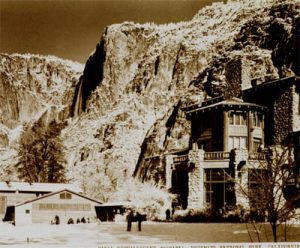
And, by the upcoming July of 1943, the Ahwahnee had been transformed completely. As country’s newest Naval Convalescent Hospital, the hotel opened its doors to wounded men returning from the Pacific theater. These were men whose wounds ran deeper than a simple infection, or a bout with Malaria. The convalescent hospitals served those who needed long-term rehabilitation for lost limbs, for men with chronic pain and men who needed to re-learn to walk. Many of the men required psychiatric care after their experiences, particularly those returning from the ceaseless undertaking at Guadalcanal. They needed time between the horrors of war and an eventual return, either to active duty or else to their mothers and girlfriends.
When Adams returned for the Christmas of 1943, Yosemite Valley was filled with hundreds of these shattered men. And his role at the Ahwahnee that year was to help organize their Christmas Party.
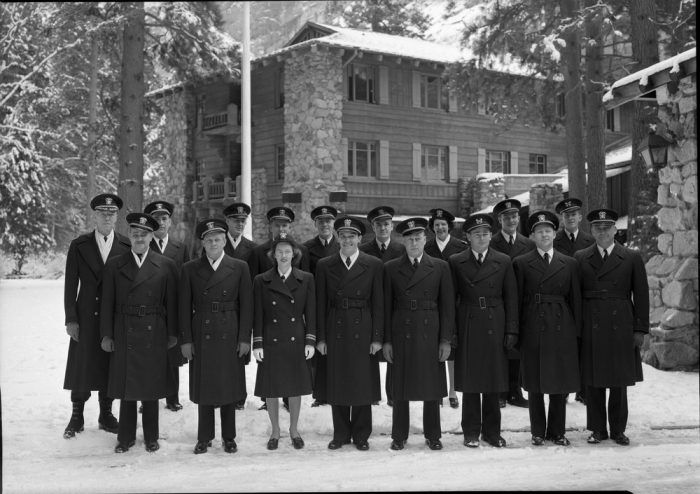
THE MEN AT AHWAHNEE
First to arrive at Ahwahnee had been the Maintenance Officer, Lieutenant Will Grimes, on May 30 of 1943. He preceded the next group of hospital corpsmen who arrived roughly a week later. Over the next month, the Navy transformed the hotel. Pictures came down off the walls, and draperies and rugs were folded away into storage; guestrooms were converted with bunks so that multiple men could sleep in each room. The Navy bought the use of the hotel’s bedroom and dining room furniture, its linens and china and silverware.
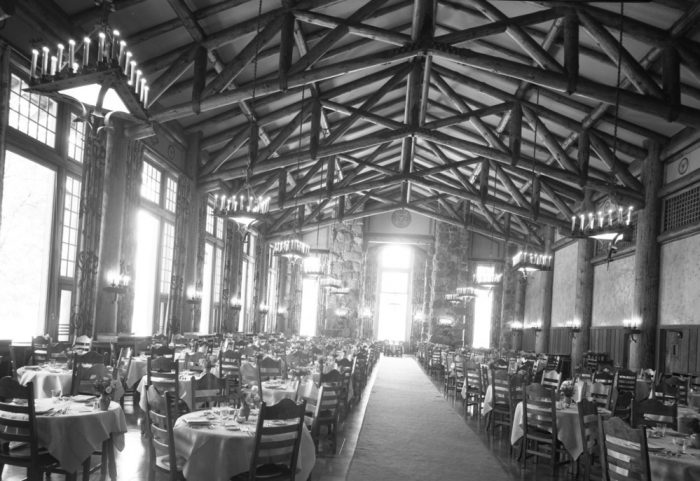
By the 6th of July, the hotel was converted into a suitable place for convalescing soldiers, and the first contingent of 49 men were sent from the Naval Hospital at Oakland.
Almost immediately, the Navy discovered it had made a mistake.
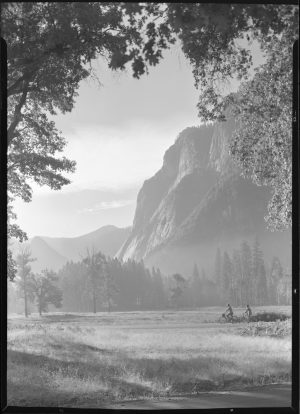
The first arrivals at Yosemite were all neuro-psychiatric cases. These men suffered from what would now be called Post-Traumatic Stress, but at the time was known as “Battle Fatigue” or “Combat Fatigue”. Some still used the World War I-era term “Shell Shock”. The idea had been that the hotel’s remote and magnificent surroundings would be a balm to the men’s shattered nerves.
But while the hospital was beautifully situated, surrounded by pines and oaks at the north bank of the Merced River, it was not a paradise for the men. The steep walls of the Valley proved painfully claustrophobic, looming over them. The enormous granite faces of Half Dome and Glacier Point dwarfed them, and the intense quiet and isolation of their surroundings meant that they spent their days trapped with their circling thoughts and excruciating memories. The Navy hadn’t managed to set up much recreation, or transportation to nearby towns. The result was a steep drop in morale. One early staff member reported, “If the patients weren’t nuts when they got to Yosemite, the boredom there soon sent them over the edge.”
Help arrived in September, with two changes. First, the Navy directed that no more neuro-psychiatric cases be sent to the Ahwahnee. The Hospital would focus on general medical and surgical cases instead. The second change was the arrival of Captain Reynolds Hayden, who took command of the hospital.
Captain Hayden was the kind of commanding officer that soldiers dream of. He had already established a reputation for intelligence, resilience, and humility. As the Chief Officer at the Naval Hospital on Pearl Harbor, he had worked relentlessly for 10 days after the December 7th attack, ministering to the constant stream of wounded and dying soldiers who were carried through its doors. He championed the use of Sulfanilamide Powder on wounds, treating devastating, massive lacerations that would have been considered fatal in the past. With Sulfanilamide, he kept wounded men alive for days as they waited to be wheeled into the operating rooms. His heroism, and the heroism of his staff made headlines across the country.
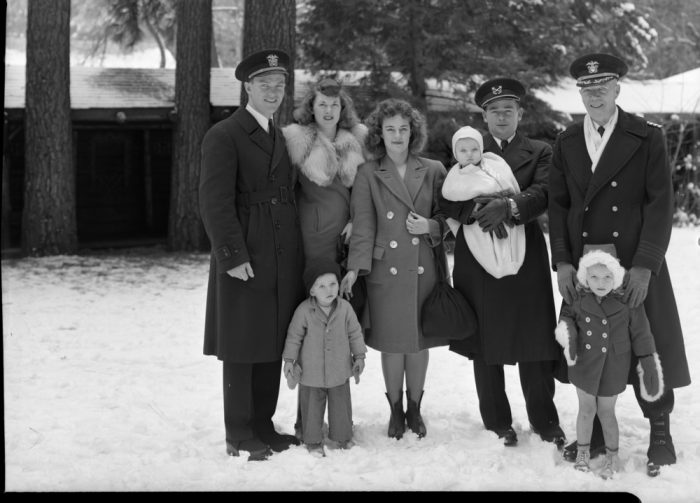
Hayden’s father had been a Navy Admiral, a geologist, a marine meteorologist, and a mountaineer. The elder Admiral Hayden was known as an accomplished expert on tropical hurricanes and the law of storms. Captain Hayden’s mother Kate was the daughter of a Major General in the Union Army. Instilled from birth with a powerful sense of duty, Hayden spent his entire career in the Navy Medical Department. His son, also named Reynolds, joined the Marine Corps at the age of 21. In 1943, young Reynolds was transferred from his post in Panama to serve in the Pacific.
Knowing that his own boy was stationed somewhere in that theater, Hayden developed an immediate and powerful bond with the young men who were transferred to his hospital in the remote valley. He threw himself entirely into the work of developing the Ahwahnee to care for them, sending off requisitions for new surgical equipment, new vehicles, and a large, ready tank of gasoline for hospital use. One of his first, and constant, requests was for a bowling alley somewhere on the grounds.
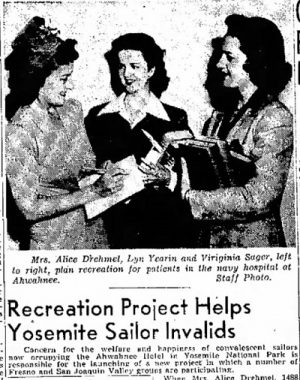
He enlisted the aid of locals. The Elks Club of San Joaquin Valley. The Navy Club and War Dads of Fresno. The Navy Mothers’ Clubs and Veterans of Foreign Wars. Word went out in each of the local towns that the men needed recreation and entertainment. They needed hostesses for dances. They needed musical acts and traveling theatrical performances. Card tables and Pool Tables. The locals, eager to help the war effort, rushed in with supplies and ideas.
Working to help Hayden inside the hospital was the newly arrived chaplain—a Catholic priest from Peoria, Illinois named Joseph Gerber. Gerber, a native of Austria and friend to the Von Trapp Family of singers, had been raised in Scranton, Pennsylvania. His father had brought the family through Ellis Island in 1909 and worked the rest of his life as a car mechanic in Scranton. Gerber was called to the priesthood in 1933, and to the Navy in April of 1943.
When Gerber arrived at the Hospital on November 22, his first task was to somehow create a chapel out of the hotel saloon. This he undertook with great creativity and speed. With the help of a patient and the hospital painter, he fashioned an altar atop the old wood-paneled bar and a communion rail from the rustic bar rail.
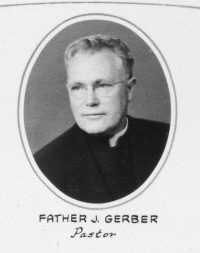
Not wanting to damage any of the original décor, which had cast the room as a frontier town, with building facades painted on the walls and wagon tracks running down the “street,” he chose to add rather than subtract. He built a large tabernacle for his altar, painted in cream and gold with a red plush background. On either side of the tabernacle were two statues, one of the Blessed Heart of Jesus and the other of the Virgin Mary. He constructed his own candlesticks and candle brackets out of discarded bits of steel, and his sanctuary’s lamp from a pickle jar, the top of a cocktail shaker and a handmade frame. His sanctuary held a shrine in honor of Our Lady of the Miraculous Medal, and also a picture of the apparition of Our Blessed Mother to blessed Catherine Laboure. The room held an organ, and also a record player for playing recorded music. And, at the rear of the room, he maintained a small library of religious books. He was able to hold mass within the week. And quickly, the chapel was declared a showpiece. Everyone who came to the hospital made a point of visiting it.
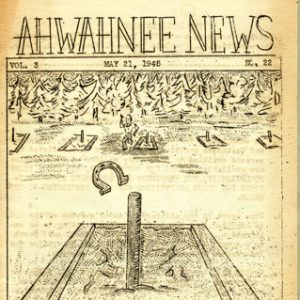
Gerber set immediately to two other morale-boosting projects. First, a library. With donations from Fresno State College, he was able to establish a small lending library. The books were loaned out of cardboard boxes until he could find a suitable room for them. And second, he helped to establish a newspaper. The Ahwahnee News, which printed its first edition that December. The Chaplain was editor-in-chief, with the educational services officer, Lieutenant Francis, and a patient, Jules Berman, as associate editors and a hospital corpsman, O.P. Nason as art editor. (The patient Berman, interestingly, went on to become the so-called “Kahlua King” of Southern California. He brought the famous liquor to America in the 1960s. Also, with his newfound wealth from liquor distribution, in 1960, he purchased California’s Lake Arrowhead, which had been the site of another Naval Hospital during the war.)
Within a month, the Ahwahnee News found its voice. One of the hospital corpsmen, Frank DeGrazia, was brought on as Editor. Without any formal training—he’d been a factory worker before Pearl Harbor—DeGrazia’s Brooklyn-tinged writing style and natural charm made the paper a hit. Articles and reprints found their way into the Hospital Corps Quarterly, the San Francisco Examiner, the Chronicle, and Esquire. When the paper was shuttered with the hospital in 1945, multiple articles were written in mourning of both the paper and its lovable editor.
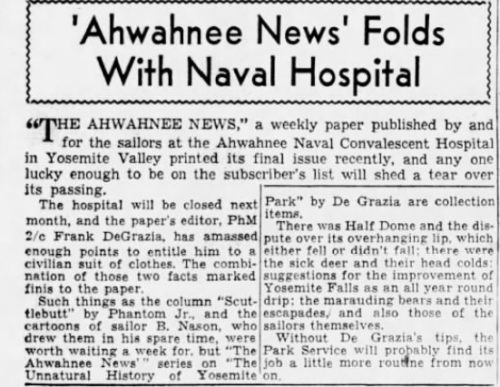
November also brought the hospital’s first USO Show, by the Shell Oil Company. This was followed shortly by another show put on by the Reynolds Tobacco Company’s Camel Caravan. Both were brought to the Valley with the help of the Fresno Navy Club.
And November brought the declaration from the Navy that the hospital was ready to receive a full capacity of patients. By December 1st, the luxury hotel housed 781 wounded Navy men. Veterans of Buna and Guadalcanal, and the numerous island-hopping battles for the South Pacific. By Christmas, men would be arriving from the devastating battle at Tarawa. Never in their lives had these men needed the comforts of a Christmas on the home front like they needed it in 1943.
Next Time: Adams Visits Manzanar Internment Camp, The Wounded Return from the Battle at Tarawa, and Everyone Shares Christmas at Ahwahnee…
Click Here to Read Part Two…
Tonya Audyn Stiles is Publisher and Managing Editor of the Canyon Country Zephyr.
Selected Bibliography:
* Ansel Adams: A Biography by Mary Street Alinder. (Amazon link)
* “History of the United States Naval Special Hospital. Yosemite National Park, California.” Printed by Yosemite Park and Curry Co. January, 15, 1946.
* The Hospital Corps Quarterly: Supplement to the United States Naval Medical Bulletin.1944
* The Archives of the ‘Yosemite Sentinel‘
* “Yosemite’s World War II Hospital.” National Park Service.
* Conversations with Ansel Adams : oral history transcript / 1972-1975. Ruth Teiser
* “From One Play, 80 Years of Tradition Ansel Adams’s ‘Bracebridge Dinner’ Still Captivates Audiences at Yosemite.” Washington Post
* Ansel Adams and the American Landscape: A Biography by Jonathan Spaulding. (Amazon link)
To comment, scroll to the bottom of the page.
Zephyr Policy: REAL NAMES ONLY on Comments!
Don’t forget the Zephyr ads! All links are hot!
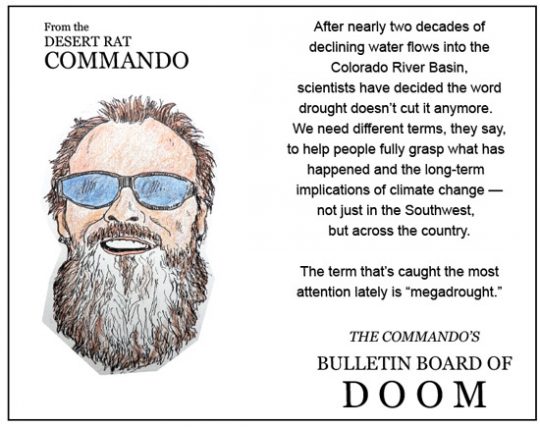
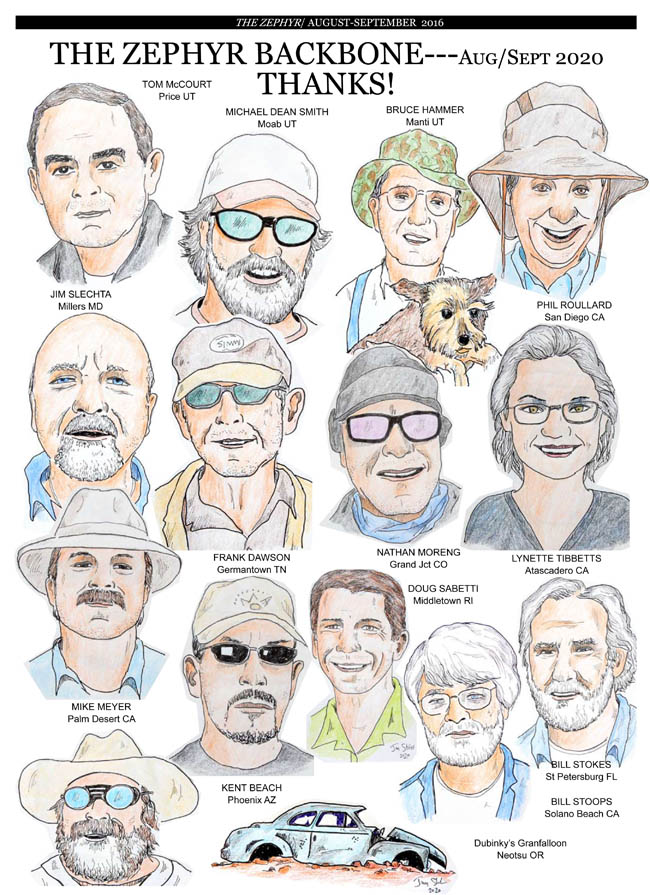




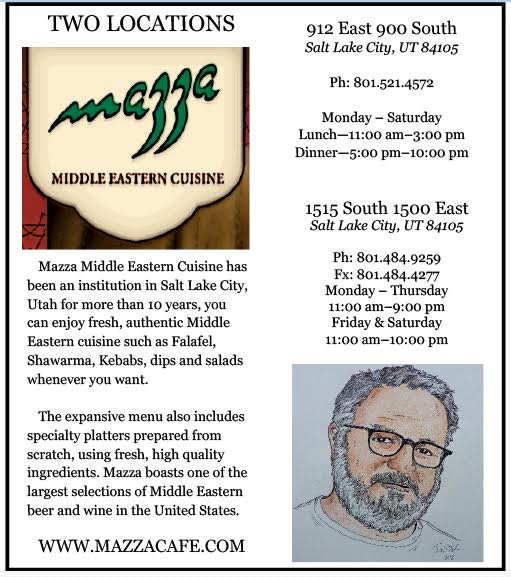

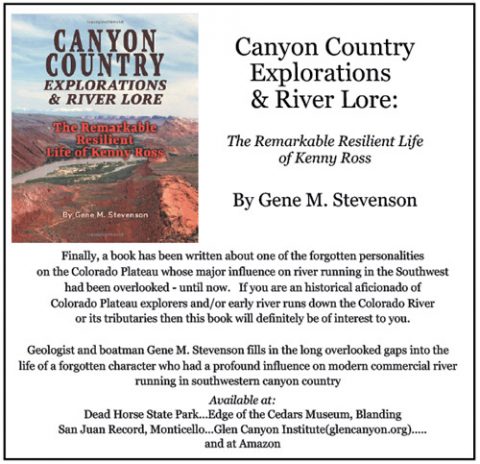
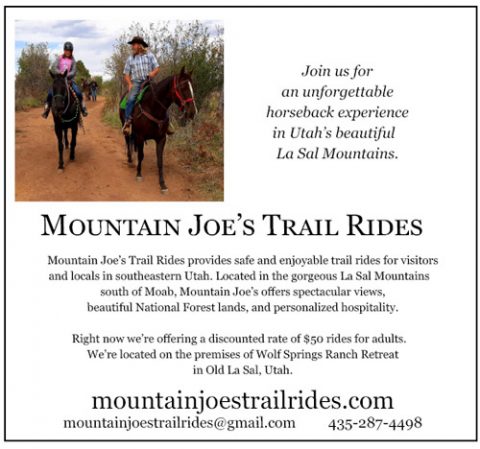

It’s hard to imagine people feeling claustrophobic over the cliffs at Yosemite, but I’ve known people who said that mountains made them feel claustrophobic, so I know it’s real. Robin and I had dinner last October at the Ahwahnee in the dining room one night, in the bar another evening and cocktails at the bar one afternoon without ever knowing that the hotel had been converted to a convalescent hospital and the bar to a library in the wake of WWII. Of course, we couldn’t really afford a room at the Ahwahnee. We always find the solitude we seek, usually by getting as far away from trails as possible. At Yosemite, that’s not always easy to do but it can be accomplished by those who don’t get lost easily. I’d say ya gotta find yourself first…
Thank you for your efforts in writing this essay, Tonya. The research is obviously extensive and thoughtfully chosen. Though perhaps more impressive than the research, is your writing style. You are tender with these people and places. Your writing here reminds me of the work of the late editor and writer for Field & Stream, Ted Trueblood. He cared for his subjects without insiting how we, his readers, should care. At the same time, I always came away from his work feeling as though I SHOULD have cared. After all, Trueblood did. So, with my compliments, you make me miss and long to know these people and places with whom and where I have never traveled.